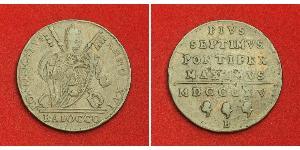(sold for $61.0)
1596, Royal France, Henry IV. Beautiful Brass "Battle of Arques" Medal. R!
Mint Year: 1596
References: F. 11851.
Mint Place: Nuremberg (Germany) for France
Condition: VF- (minor deposits and corrosion!)
Denomination: Small Medal (Jetton) - Victory of Henry IV of France Arques in 1589.
Diameter: 28mm
Material: Brass
Weight: 3.6gm
Obverse: Henry IV, in armour and brandishing a sword, riding triumphant to right over a battlefield strewn with weapons. He is wearing a commander's scarf. On the flank of his horse are the two shields of France and Navarre.
Legend: HENRICVS.IIII.GALLIAE.ET.NAVAR.REX
Reverse: Two round-based shields, of France and Navarre, flanking a drawn sword, point upwards, between two laurel branches. The blade passes through an open crown and the point penetrates a heavenly chaplet set among clouds from which proceed rays and laurels.
Legend: OMNIS.VICTORIA.A.DNO ("All victory from our Lord!")
The Battle of Arques occurred on 15–18 September 1589 between the French royal forces of King Henry IV of France and troops of the Catholic League commanded by Charles of Lorraine, Duke of Mayenne during the eighth and final war (1585-1598) of the French Wars of Religion. It was a victory for Henry IV.
At the death of Henry III of France, the Huguenot Henry of Navarre became by birthright the successor to the French throne (as Henry IV). Although he quickly declared his intention to "maintain and preserve the Catholic, apostolic and roman religion" of the country (French: "maintenir et conserver la religion catholique, apostolique et romaine"), the major French cities sided with the Catholic League and its leader, the Duke of Mayenne (younger brother to the deceased Henry I, Duke of Guise).
At that time, the royal army was in a shambles and Henry IV could only count on barely 20,000 men to conquer a rebellious country. In order to accomplish this task, he divided his troops into three commands: Henri I d'Orléans, Duke of Longueville (1568-1595) for Picardy, Jean VI d'Aumont for Champagne and Henry IV for Normandy (where he awaited reinforcements from Elizabeth I of England). On 6 August 1589, Henry set up camp with 8,000 men at the port of Dieppe.
The Duke of Mayenne sought to take back this key strategic port from Henry's forces and to drive him from Normandy. He drew together 35,000 troops, plus Cambrésis militias, Lorraine troops led by the Marquis de Pont-à-Mousson and a contingent of Spanish troops to attack the city.
Knowing that an attack against an army of this size would be pointless, and that staying in the city of Dieppe would be suicidal, Henry (after consulting with the Duke of Longueville and the Duke d'Aumont) decided to go to the city of Arques (today called "Arques-la-Bataille") and to construct important military defenses (raising of areas, rebuilding fortifications).
Between the 15 September and the 29 September 1589, the troops of the Catholic League launched several attacks on Arques and the surrounding areas, but the Duke of Mayenne's forces were countered by royal artillery. The attacks were extremely deadly for both sides, and soon Henry IV's side found itself undermanned.
Henry's rescue came from the sea on the 23 September: 4,000 English soldiers sent by Queen Elizabeth had left England in several waves over three days. Seeing these reinforcements, the Duke of Mayenne decided to retreat, leaving Henry IV victorious. After the battle of Arques, Henri IV snatched a short rest in a neighbouring chateau, and before riding away he scratched with his diamond the following aspiration on one of the windows: " Dieu gard de mal ma mie. Ce 22 de Septembre 1589.-HENRI".
Henry IV (13 December 1553 – 14 May 1610), Henri-Quatre, was King of Navarre from 1572 to 1610 and King of France from 1589 to 1610. He was the first monarch of the Bourbon branch of the Capetian dynasty in France.
Baptised Catholic, he converted to Protestantism along with his mother Jeanne d'Albret, Queen of Navarre. He inherited the throne of Navarre, in 1572, on the death of his mother. As a Huguenot, Henry was involved in the Wars of Religion, he barely escaped the St. Bartholomew's Day massacre and later led protestant forces against the French Royal Army.
As a prince de sang by his father, Antoine de Bourbon, he was also the natural heir to the throne of France. On the death of the childless Henry III, he ascended the throne of France in 1589, but had to abjure his Calvinist faith. However, his coronation was followed by a four-year war against the Catholic League to establish his legitimacy.
One of the most popular French kings, both during and after his reign, Henry showed great care for the welfare of his subjects and, as a politique, displayed an unusual religious tolerance for the time. He notably enacted the Edict of Nantes, in 1598, which guaranteed religious liberties to the Protestants, thereby effectively ending the civil war. He was assassinated by François Ravaillac, a fanatical Catholic.
Only 1$ shipping for each additional item purchased!

|
Posted by:
anonymous 2015-02-22 |
1 Ducat Salzburg Gold
group has 6 coins / 5 prices
⇑























